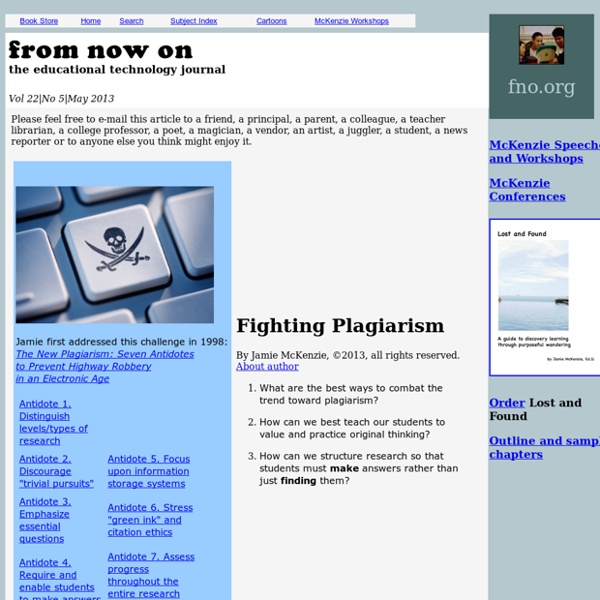Anti-Plagiarism Strategies
Robert Harris Version Date: May 18, 2015 Earlier versions: December 30, 2013; February 28, 2012; December 18, 2010; June 14, 2009; November 17, 2004 The availability of textual material in electronic format has made plagiarism easier than ever. Copying and pasting of paragraphs or even entire essays now can be performed with just a few mouse clicks.
Videos
One of the best ways to learn about Creative Commons is to watch one of our videos. What is Creative Commons? From our friends at Wikimedia, a short video describing Creative Commons licenses.
Northeastern University Libraries
What is plagiarism? The Northeastern University Academic Integrity Policy defines plagiarism as ...using as one’s own the words, ideas, data, code, or other original academic material of another without providing proper citation or attribution. Plagiarism can apply to any assignment, either final or drafted copies, and it can occur either accidentally or deliberately. Since it is a serious violation of intellectual integrity, plagiarism harms the reputation of the university as well as the individual. It is an academic integrity violation and is subject to Office of Student Conduct and Conflict Resolution (OSCCR) review.
A Copyright-Friendly Toolkit
However fabulous Creative Commons and Public Domain content may be, sometimes you really need to use copyrighted material. Say you plan to comment on popular media or current events. For instance, you may be planning to critique the portrayal of Native Americans in commercial films.
Getting Started with Primary Sources
If you can see or hear the materials on the Library of Congress website, you may view or listen to them on the site. We are making them available to you for that very purpose. If you want to use or reuse the materials beyond our website, though, you need to be aware of copyright and other rights restrictions. (Just because we’ve put a work online doesn’t mean that you can freely reuse it.) You need to decide for yourself whether the way you plan to use the materials is allowed under copyright law. For a few questions that will help you decide, visit this section of the Library’s Understanding Copyright page:
Other Side of Plagiarism
Most of my Head for the Edge columns, updated and edited, can be found in my latest book. Buy it and I might be able to afford a nicer nursing home one day. Thank you.
Copyright Infringement: 5 Myths vs Facts
Embed Code Embeded for hosted site: Click the code to copy <div class='visually_embed'><img class='visually_embed_infographic' src=' alt='Copyright Infringement: 5 Myths vs Facts' /><div class='visually_embed_cycle'><span>by </span><a target='_blank' href=' <br/></div><script type='text/javascript' src=' class='visually_embed_script' id='visually_embed_script_88270'></script><p> From <a href=' Embeded for wordpress.com:
Copyright for Educators
Copyright for Educators is a series of videos designed to help educators learn about what they can and can't do within the category of "Teaching" in the Copyright Act. Under the Copyright Act, there is nothing more intriguing and exciting for educators than Fair Use. Fair Use is the concept that if you are doing something for the greater good of society, like teaching, then your needs supersede the ownership rights of the copyright holder under the Copyright Act. Teachers, and by association, students, can legally use music, websites, videos, images, and a wealth of copyrighted materials for the purposes of teaching, that wouldn't be accessible otherwise. Still a bit intimidated?
Avoiding Plagiarism
Summary: There are few intellectual offenses more serious than plagiarism in academic and professional contexts. This resource offers advice on how to avoid plagiarism in your work. Contributors:Karl Stolley, Allen Brizee, Joshua M. PaizLast Edited: 2014-10-10 09:01:36 Research-based writing in American institutions, both educational and corporate, is filled with rules that writers, particularly beginners, aren't aware of or don't know how to follow.
Five-Minute Film Festival: Copyright and Fair Use for Educators
I absolutely love it when teachers and students create, remix, and mash up media; it's a fantastic way to encourage deeper learning and media literacy. But one issue that complicates digital freedom of expression is copyright law. While many would argue that copyright law is outdated and badly in need of an overhaul, it's still critical that adults and kids alike have a basic understanding of what's legal and ethical while playing with other people's intellectual property. Here's a list of videos I collected to help you navigate the murky waters of copyright law in educational settings. Video Playlist: Understanding Copyright and Fair Use Watch the first video below, or watch the whole playlist on YouTube.
How to Find Public Domain and Creative Commons Images
In last week's survey of Free Technology for Teachers readersFlickr The Commons, Photos for Class, and Pixabay were chosen as the best places to find public domain and Creative Commons images. All three can be used to find images that can be re-used in a variety of presentation formats. The videos embedded below provide an overview of how to use each image source. Pixabay hosts high quality public domain images. You can search on Pixabay by using keywords or you can simply browse through the library of images.



